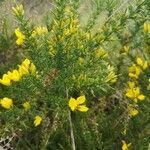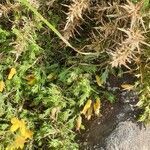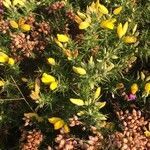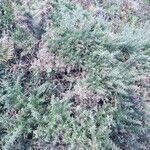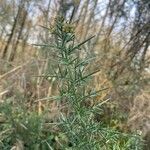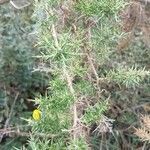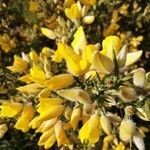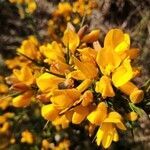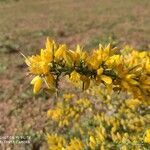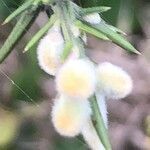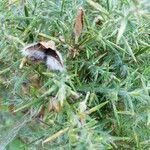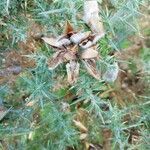Shrub up to 2 m high; main stems erect or spreading, densely branched in younger parts but eventually bare at base; young twigs and spines somewhat glaucous; hairs usually grey. Lvs of seedlings not spinous but with 3 hairy leaflets; spines branched; terminal and lateral spines rigid, deeply furrowed, 15-30 mm long; secondary spines subtending lateral up to 12 mm long. Fls solitary; bracteoles acute to ± rounded, 1.5-3 mm wide. Calyx greenish yellow, c. ?-3/4 length of corolla, with ± patent hairs; calyx teeth connivent. Corolla clear yellow or golden yellow, 13-20 mm long; wings > keel. Pod villous, turning dark brown to black, 13-25 mm long; seeds smooth and rounded, brown or greenish brown, shiny, few per pod.
Shrub, 0.5-2.0 m high; branchlets very spiny. Leaves alternate, trifoliolate on seedlings, but reduced to scale-like or narrow, usually spine-like phyllodes on mature plants. Stipules 0. Inflorescences axillary; flowers solitary, in small clusters or aggregated into racemes; bracteoles 2, immediately below flower. Flowers yellow. Calyx ± yellow, persistent, divided to base into 2 lips. Petals: standard ovate; wings and keel obtuse. Stamens monadelphous, connate into a closed tube. Ovary sessile, many-ovuled; style slightly incurved with terminal, capitate stigma. Flowering time Sept.-Apr. Pod ovate to oblong, compressed or turgid, 2-valved. Seeds 1-6, strophiolate.
Much branched shrub to 2 m, all branches ending in spiny tips; spine-tipped petioles 5–15 mm, numerous, crowded; fls short-pedicelled along the smaller branches, forming terminal panicles; each fl subtended by 2 ovate bracteoles 2–3 mm; cal loosely villous, 12–16 mm; pet subequal, 15–20 mm; pods 2–4-seeded, 1–2 cm, villous-tomentose, subtended by the persistent cal; 2n=96. Native of Europe, escaped and established in sandy soil and waste places along the coast, from Mass. to Va. June.
Much-branched, densely spiny shrub 0.5-1.5(-3.0) m high; branchlets striated, hairy when young; spines green, branched, deeply furrowed rigid and sharp-pointed, 15-35 mm Iong. Leaves: Dark green, minute; three-foliate on young plants; spinous or scale-like on mature plants. Flowers: Bright yellow, crowded towards the ends of branchlets, fragrant, spring-all year. Fruits: Dark brown or black pods, hairy, 20-25 mm long.
An evergreen shrub. It grows 2 m high and spreads 2 m wide. The stem is sturdy and hairy. It has many branches. Young plants have small compound leaves with 3 leaflets. Later the leaves are thread-like spines. The flowers are golden yellow. They are pea like. They are fragrant.
